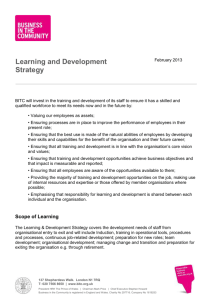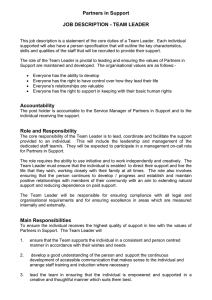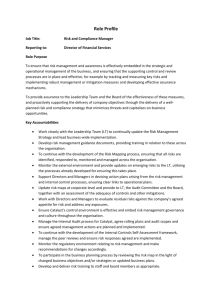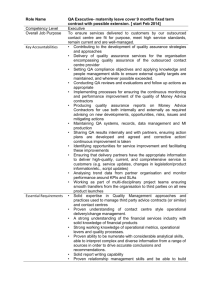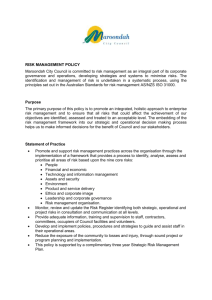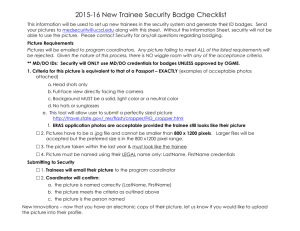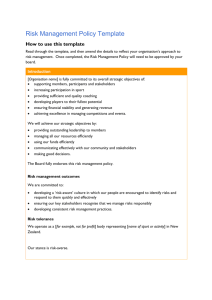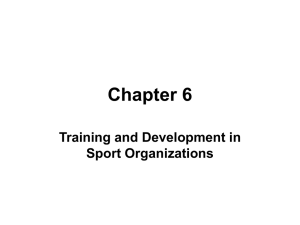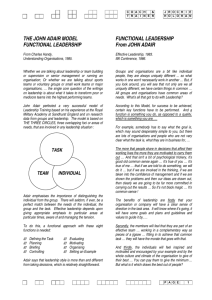Developing Yourself as a Team Leader
advertisement
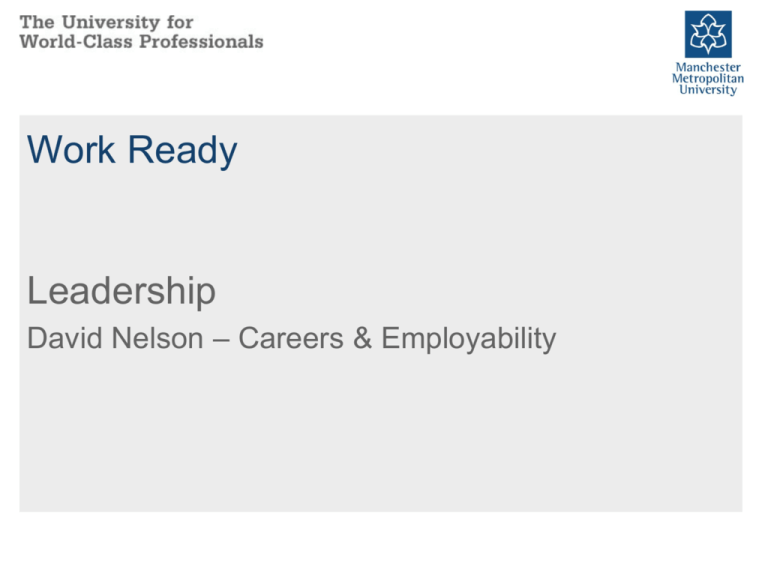
Work Ready Leadership David Nelson – Careers & Employability Agenda • What leaders do – John Adair’s Action Centred Leadership model • Characteristics of good leaders • Differences between Leadership & Management • Giving Feedback • Examples of how employers interpret Leadership Leadership Activity Group 1 • What is leadership? • What behaviours would you expect to see from an effective team leader? Group 2 • What is leadership? • Identify the issues you might have to deal with as a leader /manager of a team. Group 3 • What is leadership? • What could happen to a team without an effective leader? Some Leadership Definitions “Leadership is a process whereby an individual influences a group of individuals to achieve a common goal”. (Northouse, 2004) “Leadership is the ability of an individual to influence, motivate, and enable others to contribute toward the effectiveness and success of the organization…” (House et al., 1999) “Leadership is the art of getting someone else to do something you want done because he wants to do it.” (Dwight D. Eisenhower ) “Leadership is influence.” (John C. Maxwell ) Team Leaders do the Following CONTROL DAY – to- DAY RESPONSIBILITY COMMUNICATION John Adair’s Action Centred Leadership Model The Team • Being aware of the benefits of team working and promoting these benefits to team members. • Ensuring that members of the team are aware of their roles, both task roles – the jobs they do; and team roles – how they help other members of the team to perform effectively. • Helping to build effective working relationships between members of the team and ensuring that the team’s norms and cultures do not exclude anyone. The Team • Sharing power with the team in decision making • Helping to build the team, encouraging team members to work together, to solve problems and develop themselves • Helping new members of the team to settle in and perform effectively The Task • Safely – ensuring health and safety of self the team and the customers; ensuring a safe environment. • Making sure the most effective systems and procedures are used, ensuring quality of goods and services. • Making sure that the correct resources for the task are used and used correctly. The Individual • Treating people fairly • Building effective working relationships • Having good communication skills • Improving team members skills • Handling conflict • Dealing with personal issues Leadership Attributes – Diamond 9 • Discuss the attributes on the tiles and place on the grid, based on how important you think they are as a leader… Motivation - Maslow’s Hierarchy of Needs Motivation - Maslow’s Hierarchy of Needs 1. Biological and Physiological needs - air, food, drink, shelter, warmth, reproduction, sleep, etc. 2. Safety needs - protection from elements, security, order, law, limits, stability, etc. 3. Belonging and Love needs - work group, family, affection, relationships, etc. 4. Esteem needs - self-esteem, achievement, mastery, independence, status, dominance, prestige, managerial responsibility, etc. 5. Self-Actualization needs - realising personal potential, self-fulfilment, seeking personal growth and peak experiences. Differences Between Leadership & Management - Are there any differences? Are there any similarities? Can we come up with a definition of Leadership? Each group spend a couple of minutes deciding on a definition of Leadership. Leadership for a new Graduate Trainee • Leadership from day one • Leadership in how you conduct yourself with others • Leadership in how you think strategically in the organisation • You don’t have to be managing people from day one to be a Leader Leadership & Managing Tasks In your groups: • Look at the list of tasks/phrases provided • Which are Leadership & which are Managing? • Feedback and discuss. Importance of feedback It lets the recipient know: • • • • • what the standards are; how they are doing; what they need to change to meet the standards; how long they have to improve; what support they can expect from you. The Feedback Sandwich Delivering Feedback - What do you see on the flip chart? • • • • • Keep an open mind Seek agreement Focus on facts, not the person Be respectful & courteous Prepare for the discussion Organisation Development & Training Delivering Negative Feedback - CEDAR • Clarify – define the precise performance problem. • Explain – present your view of the issue. • Discuss – listen to the response and discuss the situation. • Agree – on the issue and action. • Review Organisation Development & Training Centrica Graduate Recruitment “Exceptional leadership is not a factor of job title or level of seniority but of attitude, behaviours and a desire to take responsibility. It is about having a goal, the courage to follow it and the tenacity to take people on the journey with you”. • Sam Laidlaw Chief Executive, Centrica Leadership Attributes - NEXT • "Leadership is a big part of our trainee scheme in terms of decision making and taking responsibility for persuading others to your way of thinking. It is paramount to both buyer and merchandising roles at Next. I guess the ultimate aim for Next is to recruit Future leaders of our business - we simply do not look for good trainees. Instead we look at a candidate's potential to make it beyond Trainee Level in buying and merchandising. After all, it is a career choice, so why not aim as far as you can go. • When a successful Clothing and Homeware retailer like Next has promoted over 65% of trainees, over the past 5 years, it’s fair to say that we look at leadership very early on during the recruitment process and the evidence to prove it is absolutely necessary for our business to grow stronger than ever." Leadership Attributes – John Lewis • Application Form - Team Leader - Evidence of working in a management or leadership capacity with a clear demonstration of responsibility for team’s performance, and personal reflection on performance. • Assessment Centre - Candidates are assessed against our Leadership Behaviours. These behaviours have been identified as a method of measuring leadership and performance and are centred around the business goals of achieving: strategic vision, transformational change, profitability, and competitiveness John Lewis – Leadership Attributes: • • • • • • Sets vision and direction Shows strategic agility Drives performance Takes decisive action Works across boundaries Acts with courage Thank You for Attending – Please can I have some feedback?? • • • • What did you learn over the course? What worked well? What didn’t work so well? Any suggestions of what could be added?
